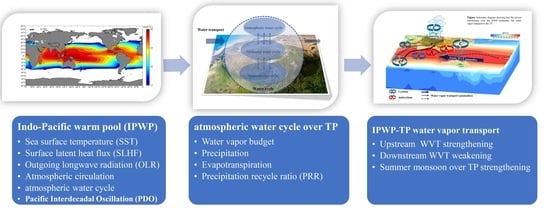The Variability of Summer Atmospheric Water Cycle over the Tibetan Plateau and Its Response to the Indo-Pacific Warm Pool
Abstract
:1. Introduction
2. Data and Methodology
2.1. Data and Study Area
2.2. Methodology
3. Results
3.1. The WVT and Atmospheric Water Cycle on the TP
3.1.1. Temporal and Spatial Changes in Atmospheric Water Cycle Elements on the TP
3.1.2. The Variability of PRR over the TP
3.1.3. The Relationship between WVT and the TPSM on the TP
3.2. The Spatiotemporal Changes in the Indo-Pacific Warm Pool
3.2.1. Spatiotemporal Changes in SST and SLHF in the IPWP
3.2.2. Spatiotemporal Changes in the OLR in the TP and IPWP
3.3. The Relationship between the Summer WVT of the TP and the Climate Index and the IPWP
4. Discussion
5. Conclusions
Author Contributions
Funding
Institutional Review Board Statement
Informed Consent Statement
Data Availability Statement
Acknowledgments
Conflicts of Interest
References
- Vörösmarty, C.J.; Green, P.; Salisbury, J.; Lammers, R.B. Global Water Resources: Vulnerability from Climate Change and Population Growth. Science 2000, 289, 284–288. [Google Scholar] [CrossRef] [PubMed] [Green Version]
- Yao, T.; Wu, G.; Xu, B.; Wang, W.; Gao, J.; An, B. Asian Water Tower Change and Its Impacts. Bull. Chin. Acad. Sci. 2019, 34, 1203–1209. [Google Scholar]
- Immerzeel, W.W.; Van Beek, L.P.H.; Bierkens, M.F.P. Climate change will affect the Asian Water Towers. Science 2010, 328, 1382–1385. [Google Scholar] [CrossRef] [PubMed]
- Seager, R.; Naik, N.; Vecchi, G. Thermodynamic and Dynamic Mechanisms for Large-Scale Changes in the Hydrological Cycle in Response to Global Warming. J. Clim. 2010, 23, 4651–4668. [Google Scholar] [CrossRef] [Green Version]
- Yang, K.; Ye, B.; Zhou, D.; Wu, B.; Foken, T.; Qin, J.; Zhou, Z. Response of hydrological cycle to recent climate changes in the Tibetan Plateau. Clim. Chang. 2011, 109, 517–534. [Google Scholar] [CrossRef]
- Liu, Y.; Lu, M.; Yang, H.; Duan, A.; He, B.; Yang, S.; Wu, G. Land–atmosphere–ocean coupling associated with the Tibetan Plateau and its climate impacts. Natl. Sci. Rev. 2020, 7, 534–552. [Google Scholar] [CrossRef] [Green Version]
- Zhang, G.; Yao, T.; Xie, H.; Yang, K.; Zhu, L.; Shum, C.; Bolch, T.; Yi, S.; Allen, S.; Jiang, L.; et al. Response of Tibetan Plateau lakes to climate change: Trends, patterns, and mechanisms. Earth-Sci. Rev. 2020, 208, 103269. [Google Scholar] [CrossRef]
- Zhao, Y.; Wang, Y.; Xu, X.; Dong, L. Effect of the Asian Water Tower over the Qinghai-Tibet Plateau and the characteristics of atmospheric water circulation. Chin. Sci. Bull. 2019, 64, 2830–2841. [Google Scholar] [CrossRef] [Green Version]
- Hao, D.; Wen, J.; Xiao, Q.; Lin, X.; You, D.; Tang, Y.; Liu, Q.; Zhang, S. Sensitivity of Coarse-Scale Snow-Free Land Surface Shortwave Albedo to Topography. J. Geophys. Res. Atmos. 2019, 124, 9028–9045. [Google Scholar] [CrossRef]
- Zhang, J.; Liu, J.; Jin, J.; Ma, T.; Wang, G.; Liu, H.; Min, X.; Wang, H.; Lin, J.; Bao, Z.; et al. Evolution and Trend of Water Resources in Qinghai-Tibet Plateau. Bull. Chin. Acad. Sci. 2019, 34, 1264–1273. [Google Scholar]
- You, Q.; Liu, J.; Pepin, N. Changes of summer cloud water content in China from ERA-Interim reanalysis. Glob. Planet. Chang. 2019, 175, 201–210. [Google Scholar] [CrossRef] [Green Version]
- Wang, Z.; Duan, A.; Yang, S.; Ullah, K. Atmospheric moisture budget and its regulation on the variability of summer precipitation over the Tibetan Plateau. J. Geophys. Res. Atmos. 2017, 122, 614–630. [Google Scholar] [CrossRef]
- Fu, Y.; Ma, Y.; Zhong, L.; Yang, Y.; Guo, X.; Wang, C.; Xu, X.; Yang, K.; Xu, X.; Liu, L.; et al. Land-surface processes and summer-cloud-precipitation characteristics in the Tibetan Plateau and their effects on downstream weather: A review and perspective. Natl. Sci. Rev. 2020, 7, 500–515. [Google Scholar] [CrossRef] [PubMed] [Green Version]
- Yao, T.; Xue, Y.; Chen, D.; Chen, F.; Thompson, L.; Cui, P.; Koike, T.; Lau, W.K.-M.; Lettenmaier, D.; Mosbrugger, V.; et al. Recent Third Pole’s Rapid Warming Accompanies Cryospheric Melt and Water Cycle Intensification and Interactions between Monsoon and Environment: Multidisciplinary Approach with Observations, Modeling, and Analysis. Bull. Am. Meteorol. Soc. 2019, 100, 423–444. [Google Scholar] [CrossRef]
- Gimeno, L.; Vázquez, M.; Eiras-Barca, J.; Sorí, R.; Stojanovic, M.; Algarra, I.; Nieto, R.; Ramos, A.; Durán-Quesada, A.M.; Dominguez, F. Recent progress on the sources of continental precipitation as revealed by moisture transport analysis. Earth-Sci. Rev. 2019, 201, 103070. [Google Scholar] [CrossRef]
- Cuo, L.; Zhang, Y. Spatial patterns of wet season precipitation vertical gradients on the Tibetan Plateau and the surroundings. Sci. Rep. 2017, 7, 5057. [Google Scholar] [CrossRef]
- Wang, Y.; Yang, K.; Zhou, X.; Chen, D.; Lu, H.; Ouyang, L.; Chen, Y.; Wang, B. Synergy of orographic drag parameterization and high resolution greatly reduces biases of WRF-simulated precipitation in central Himalaya. Clim. Dyn. 2020, 54, 1729–1740. [Google Scholar] [CrossRef]
- Zhang, C.; Tang, Q.; Chen, D.; van der Ent, R.; Liu, X.; Li, W.; Haile, G.G. Moisture Source Changes Contributed to Different Precipitation Changes over the Northern and Southern Tibetan Plateau. J. Hydrometeorol. 2019, 20, 217–229. [Google Scholar] [CrossRef]
- An, W.; Hou, S.; Zhang, Q.; Zhang, W.; Wu, S.; Xu, H.; Pang, H.; Wang, Y.; Liu, Y. Enhanced Recent Local Moisture Recycling on the Northwestern Tibetan Plateau Deduced from Ice Core Deuterium Excess Records. J. Geophys. Res. Atmos. 2017, 122. [Google Scholar] [CrossRef] [Green Version]
- Guo, Y.; Wang, C. Trends in precipitation recycling over the Qinghai–Xizang Plateau in last decades. J. Hydrol. 2014, 517, 826–835. [Google Scholar] [CrossRef]
- Guo, L.; Klingaman, N.P.; Demory, M.-E.; Vidale, P.L.; Turner, A.G.; Stephan, C.C. The contributions of local and remote atmospheric moisture fluxes to East Asian precipitation and its variability. Clim. Dyn. 2018, 51, 4139–4156. [Google Scholar] [CrossRef] [Green Version]
- Brubaker, K.L.; Entekhabi, D.; Eagleson, P.S. Estimation of Continental Precipitation Recycling. J. Clim. 1993, 6, 1077–1089. [Google Scholar] [CrossRef] [Green Version]
- Gao, Y.; Chen, F.; Miguez-Macho, G.; Li, X. Understanding precipitation recycling over the Tibetan Plateau using tracer analysis with WRF. Clim. Dyn. 2020, 55, 2921–2937. [Google Scholar] [CrossRef]
- Arnault, J.; Knoche, R.; Wei, J.; Kunstmann, H. Evaporation tagging and atmospheric water budget analysis with WRF: A regional precipitation recycling study for West Africa. Water Resour. Res. 2016, 52, 1544–1567. [Google Scholar] [CrossRef]
- Zhao, L.; Liu, X.; Wang, N.; Kong, Y.; Song, Y.; He, Z.; Liu, Q.; Wang, L. Contribution of recycled moisture to local precipitation in the inland Heihe River Basin. Agric. For. Meteorol. 2019, 271, 316–335. [Google Scholar] [CrossRef]
- Zhu, G.; Guo, H.; Qin, D.; Pan, H.; Zhang, Y.; Jia, W.; Ma, X. Contribution of recycled moisture to precipitation in the monsoon marginal zone: Estimate based on stable isotope data. J. Hydrol. 2018, 569, 423–435. [Google Scholar] [CrossRef]
- Yao, J.; Chen, Y.; Zhao, Y.; Guan, X.; Mao, W.; Yang, L. Climatic and associated atmospheric water cycle changes over the Xinjiang, China. J. Hydrol. 2020, 585, 124823. [Google Scholar] [CrossRef]
- Hua, L.; Zhong, L.; Ke, Z. Characteristics of the precipitation recycling ratio and its relationship with regional precipitation in China. Theor. Appl. Climatol. 2015, 127, 513–531. [Google Scholar] [CrossRef]
- Zhao, Y.; Zhou, T. Interannual Variability of Precipitation Recycle Ratio Over the Tibetan Plateau. J. Geophys. Res. Atmos. 2021, 126, e2020JD033733. [Google Scholar] [CrossRef]
- Yang, S.; Zhang, W.; Chen, B.; Xu, X.; Zhao, R. Remote moisture sources for 6-h summer precipitation over the Southeastern Tibetan Plateau and its effects on precipitation intensity. Atmos. Res. 2019, 236, 104803. [Google Scholar] [CrossRef]
- Liu, Z.; Tian, L.; Yao, T.; Yu, W. Seasonal deuterium excess in Nagqu precipitation: Influence of moisture transport and recycling in the middle of Tibetan Plateau. Environ. Earth Sci. 2007, 55, 1501–1506. [Google Scholar] [CrossRef]
- Zhu, X.; Wu, T.; Hu, G.; Wang, S.; Wu, X.; Li, R.; Wang, W.; Wen, A.; Ni, J.; Li, X.; et al. Long-distance atmospheric moisture dominates water budget in permafrost regions of the central Qinghai-Tibet Plateau. Hydrol. Processes 2020, 34. [Google Scholar] [CrossRef]
- Wang, S.; Zhang, M.; Che, Y.; Chen, F.; Qiang, F. Contribution of recycled moisture to precipitation in oases of arid central Asia: A stable isotope approach. Water Resour. Res. 2016, 52, 3246–3257. [Google Scholar] [CrossRef] [Green Version]
- Kong, Y.; Pang, Z.; Froehlich, K. Quantifying recycled moisture fraction in precipitation of an arid region using deuterium excess. Tellus B Chem. Phys. Meteorol. 2013, 65. [Google Scholar] [CrossRef]
- Zongxing, L.; Qi, F.; Wang, Q.; Song, Y.; Hongyi, L.; Yongge, L. The influence from the shrinking cryosphere and strengthening evopotranspiration on hydrologic process in a cold basin, Qilian Mountains. Glob. Planet. Chang. 2016, 144, 119–128. [Google Scholar] [CrossRef]
- Zongxing, L.; Qi, F.; Wang, Q.; Yanlong, K.; Aifang, C.; Song, Y.; Yongge, L.; Jianguo, L.; Xiaoyan, G. Contributions of local terrestrial evaporation and transpiration to precipitation using δ 18 O and D-excess as a proxy in Shiyang inland river basin in China. Glob. Planet. Chang. 2016, 146, 140–151. [Google Scholar] [CrossRef]
- Kang, H.; Yu, X.; Fu, X.; Xu, X. Precipitation Recycling over the Northern China. Q. J. Appl. Meteorol. 2005, 16, 139–147. [Google Scholar]
- Hai, H.E.; Guihua, L.U. Precipitation Recycling in Tarim River Basin. J. Hydrol. Eng. 2013, 18, 1549–1556. [Google Scholar] [CrossRef]
- Zhang, H.; Xu, Y.; Gao, Y. Simulation Study on Precipitation Recycling Ratio in the Tibetan Plateau from 1982 to 2005. Adv. Earth Sci. 2020, 35, 297–307. [Google Scholar]
- Pan, C.; Zhu, B.; Gao, J.; Kang, H.; Zhu, T. Quantitative identification of moisture sources over the Tibetan Plateau and the relationship between thermal forcing and moisture transport. Clim. Dyn. 2018, 52, 181–196. [Google Scholar] [CrossRef]
- Yang, M.; Yao, T.; Wang, H.; Tian, L.; Gou, X. Estimating the criterion for determining water vapour sources of summer precipitation on the northern Tibetan Plateau. Hydrol. Processes 2005, 20, 505–513. [Google Scholar] [CrossRef]
- Chen, B.; Zhang, W.; Yang, S.; Xu, X. Identifying and contrasting the sources of the water vapor reaching the subregions of the Tibetan Plateau during the wet season. Clim. Dyn. 2019, 53, 6891–6907. [Google Scholar] [CrossRef]
- Zhou, C.; Zhao, P.; Chen, J. The Interdecadal Change of Summer Water Vapor over the Tibetan Plateau and Associated Mechanisms. J. Clim. 2019, 32, 4103–4119. [Google Scholar] [CrossRef]
- Tang, Q.; Liu, X.; Zhou, Y.; Wang, J.; Yun, X. Cascading Impacts of Asian Water Tower Change on Downstream Water Systems. Bull. Chin. Acad. Sci. 2019, 34, 1306–1312. [Google Scholar]
- Zhang, Y.; Huang, W.; Zhong, D. Major Moisture Pathways and Their Importance to Rainy Season Precipitation over the Sanjiangyuan Region of the Tibetan Plateau. J. Clim. 2019, 32, 6837–6857. [Google Scholar] [CrossRef]
- Xu, K.; Zhong, L.; Ma, Y.; Zou, M.; Huang, Z. A study on the water vapor transport trend and water vapor source of the Tibetan Plateau. Theor. Appl. Clim. 2020, 140, 1031–1042. [Google Scholar] [CrossRef]
- He, B.; Liu, Y.; Wu, G.; Wang, Z.; Bao, Q. The role of air-sea interactions in regulating the thermal effect of the Tibetan–Iranian Plateau on the Asian summer monsoon. Clim. Dyn. 2018, 52, 4227–4245. [Google Scholar] [CrossRef] [Green Version]
- Wang, B.; Li, J.; He, Q. Variable and robust East Asian monsoon rainfall response to El Niño over the past 60 years (1957–2016). Adv. Atmos. Sci. 2017, 34, 1235–1248. [Google Scholar] [CrossRef]
- Wei, W.; Zhang, R.; Wen, M.; Yang, S. Relationship between the Asian Westerly Jet Stream and Summer Rainfall over Central Asia and North China: Roles of the Indian Monsoon and the South Asian High. J. Clim. 2017, 30, 537–552. [Google Scholar] [CrossRef]
- Sun, B.; Wang, H. Interannual Variation of the Spring and Summer Precipitation over the Three River Source Region in China and the Associated Regimes. J. Clim. 2018, 31, 7441–7457. [Google Scholar] [CrossRef]
- Sun, J.; Yang, K.; Guo, W.; Wang, Y.; He, J.; Lu, H. Why Has the Inner Tibetan Plateau Become Wetter since the Mid-1990s? J. Clim. 2020, 33, 8507–8522. [Google Scholar] [CrossRef]
- Xie, S.-P.; Kosaka, Y.; Du, Y.; Hu, K.; Chowdary, J.S.; Huang, G. Indo-western Pacific ocean capacitor and coherent climate anomalies in post-ENSO summer: A review. Adv. Atmos. Sci. 2016, 33, 411–432. [Google Scholar] [CrossRef] [Green Version]
- Sun, B.; Wang, H. Enhanced connections between summer precipitation over the Three-River-Source region of China and the global climate system. Clim. Dyn. 2018, 52, 3471–3488. [Google Scholar] [CrossRef]
- Wang, L.; Huang, G.; Chen, W.; Zhou, W.; Wang, W. Wet-to-dry shift over Southwest China in 1994 tied to the warming of tropical warm pool. Clim. Dyn. 2018, 51, 3111–3123. [Google Scholar] [CrossRef]
- Zhang, J.; Chen, H.; Zhao, S. A Tripole Pattern of Summertime Rainfall and the Teleconnections Linking Northern China to the Indian Subcontinent. J. Clim. 2019, 32, 3637–3653. [Google Scholar] [CrossRef]
- Sugimoto, S.; Ueno, K.; Sha, W. Transportation of Water Vapor into the Tibetan Plateau in the Case of a Passing Synoptic-Scale Trough. J. Meteorol. Soc. Jpn. 2008, 86, 935–949. [Google Scholar] [CrossRef] [Green Version]
- Kong, F.; Dong, Q.; Xiang, K.; Yin, Z.; Li, Y.; Liu, J. Spatiotemporal Variability of Remote Sensing Ocean Net Primary Production and Major Forcing Factors in the Tropical Eastern Indian and Western Pacific Ocean. Remote Sens. 2019, 11, 391. [Google Scholar] [CrossRef] [Green Version]
- Meng, D.; Dong, Q.; Kong, F.; Yin, Z.; Li, Y.; Liu, J. Spatio-Temporal Variations of Water Vapor Budget over the Tibetan Plateau in Summer and Its Relationship with the Indo-Pacific Warm Pool. Atmosphere 2020, 11, 828. [Google Scholar] [CrossRef]
- Lian, T.; Chen, D.; Tang, Y.; Jin, B. A theoretical investigation of the tropical Indo-Pacific tripole mode. Sci. China Earth Sci. 2013, 57, 174–188. [Google Scholar] [CrossRef]
- Yin, Z.; Dong, Q.; Kong, F.; Cao, D.; Long, S. Seasonal and Interannual Variability of the Indo-Pacific Warm Pool and its Associated Climate Factors Based on Remote Sensing. Remote Sens. 2020, 12, 1062. [Google Scholar] [CrossRef] [Green Version]
- Cai, Z.; Tian, L. Processes Governing Water Vapor Isotope Composition in the Indo-Pacific Region: Convection and Water Vapor Transport. J. Clim. 2016, 29, 8535–8546. [Google Scholar] [CrossRef]
- Wu, J.; Gao, X.J. A gridded daily observation dataset over China region and comparison with the other datasets. Chin. J. Geophys. 2013, 56, 1102–1111. [Google Scholar] [CrossRef]
- Kobayashi, S.; Ota, Y.; Harada, Y.; Ebita, A.; Moriya, M.; Onoda, H.; Onogi, K.; Kamahori, H.; Kobayashi, C.; Endo, H.; et al. The JRA-55 Reanalysis: General Specifications and Basic Characteristics. J. Meteorol. Soc. Jpn. 2015, 93, 5–48. [Google Scholar] [CrossRef] [Green Version]
- Harada, Y.; Kamahori, H.; Kobayashi, C.; Endo, H.; Kobayashi, S.; Ota, Y.; Onoda, H.; Onogi, K.; Miyaoka, K.; Takahashi, K. The JRA-55 Reanalysis: Representation of Atmospheric Circulation and Climate Variability. J. Meteorol. Soc. Jpn. 2016, 94, 269–302. [Google Scholar] [CrossRef] [Green Version]
- Hersbach, H.; Bell, B.; Berrisford, P.; Hirahara, S.; Horanyi, A.; Muñoz-Sabater, J.; Nicolas, J.; Peubey, C.; Radu, R.; Schepers, D.; et al. The ERA5 global reanalysis. Q. J. R. Meteorol. Soc. 2020, 146, 1999–2049. [Google Scholar] [CrossRef]
- Liu, Z.; Shi, C.; Zhou, Z.; Jiang, L.; Liang, X.; Zhang, T.; Liao, J.; Liu, J.; Wang, M.; Yao, S. CMA global reanalysis (CRA-40): Status and plans. In Proceedings of the 5th International Conference on Reanalysis, Rome, Italy, 13–17 November 2017; pp. 13–17. [Google Scholar]
- Zhao, D.; Zhang, L.; Zhou, T.; Liu, J. Contributions of Local and Remote Atmospheric Moisture Fluxes to East China Precipitation Estimated from CRA-40 Reanalysis. J. Meteorol. Res. 2021, 35, 32–45. [Google Scholar] [CrossRef]
- Schreck, C.; Lee, H.-T.; Knapp, K.R. HIRS Outgoing Longwave Radiation—Daily Climate Data Record: Application toward Identifying Tropical Subseasonal Variability. Remote Sens. 2018, 10, 1325. [Google Scholar] [CrossRef] [Green Version]
- Rayner, N.A.; Parker, D.E.; Horton, E.B.; Folland, C.K.; Alexander, L.; Rowell, D.P.; Kent, E.; Kaplan, A.L. Global analyses of sea surface temperature, sea ice, and night marine air temperature since the late nineteenth century. J. Geophys. Res. Space Phys. 2003, 108, D14. [Google Scholar] [CrossRef]
- Zhang, Y.; Wallace, J.M.; Battisti, D.S. ENSO-like interdecadal variability: 1900-93. J. Clim. 1997, 10, 1004–1020. [Google Scholar] [CrossRef]
- Zhang, G.; Yao, T.; Xie, H.; Kang, S.; Lei, Y. Increased mass over the Tibetan Plateau: From lakes or glaciers? Geophys. Res. Lett. 2013, 40, 2125–2130. [Google Scholar] [CrossRef]
- Li, R.; Wang, C. Precipitation recycling using a new evapotranspiration estimator for Asian-African arid regions. Theor. Appl. Clim. 2019, 140, 1–13. [Google Scholar] [CrossRef]
- Zhou, Y.; Fan, G.; Hua, W.; Wang, B.; Zhu, L.; Zhou, D. Distribution Characteristics of Plateau Monsoon and a Contrastive Analysis of Plateau Monsoon Index. Plateau Meteorol. 2015, 34, 1517–1530. [Google Scholar]
- Maoqiu, J.; Xiaohao, Q.; Yunting, Q.; Zhiping, W. Spatial and Temporal Variations of Large-scale Atmospheric Moisture Sinks over Southern China in Spring. Adv. Clim. Chang. Res. 2007, 2, 74–79. [Google Scholar]
- Jiang, X.; Ting, M. A Dipole Pattern of Summertime Rainfall across the Indian Subcontinent and the Tibetan Plateau. J. Clim. 2017, 30, 9607–9620. [Google Scholar] [CrossRef]
- Wang, Z.; Duan, A.; Yang, S. Potential regulation on the climatic effect of Tibetan Plateau heating by tropical air-sea coupling in regional models. Clim. Dyn. 2018, 52, 1685–1694. [Google Scholar] [CrossRef]
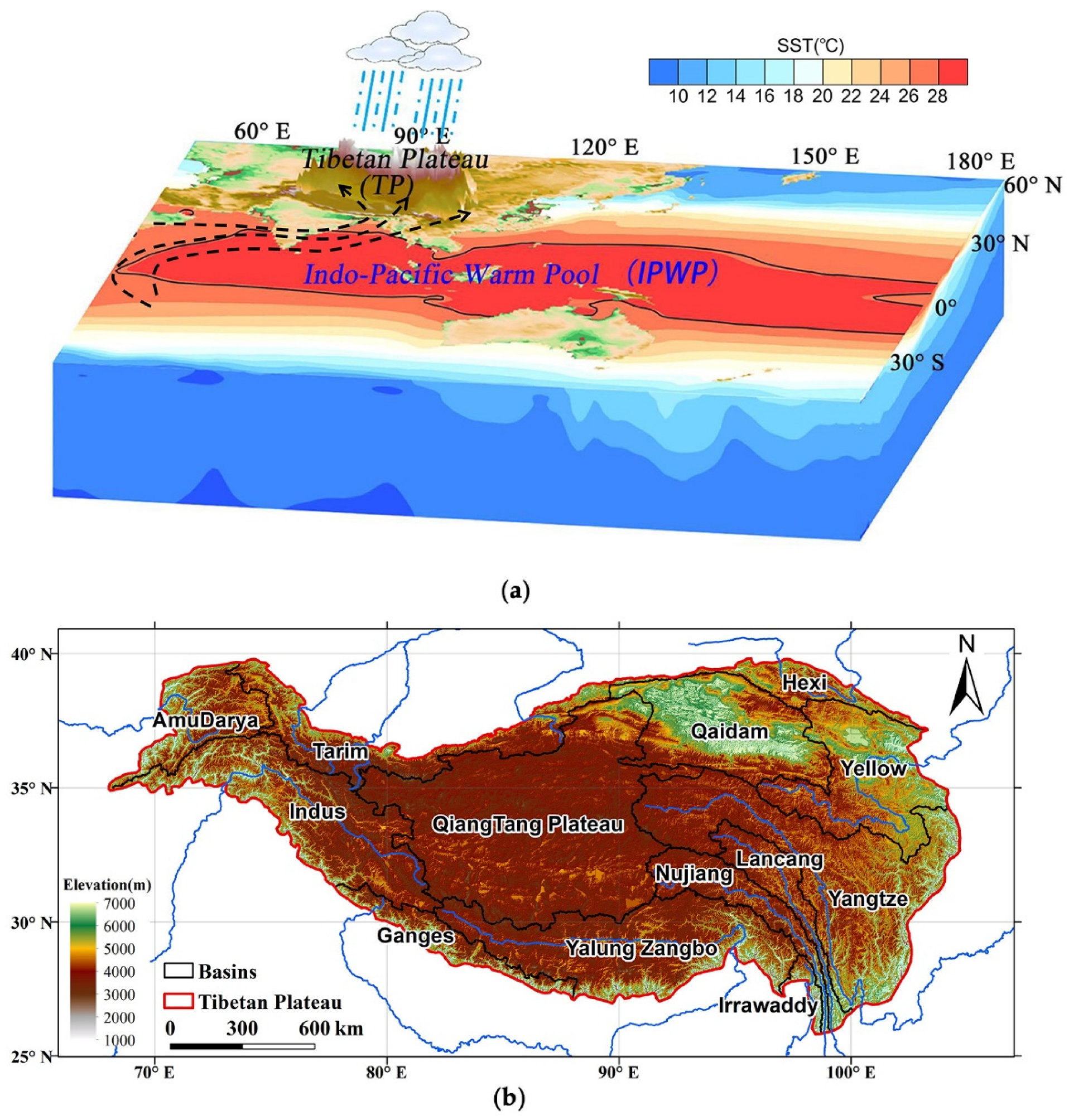
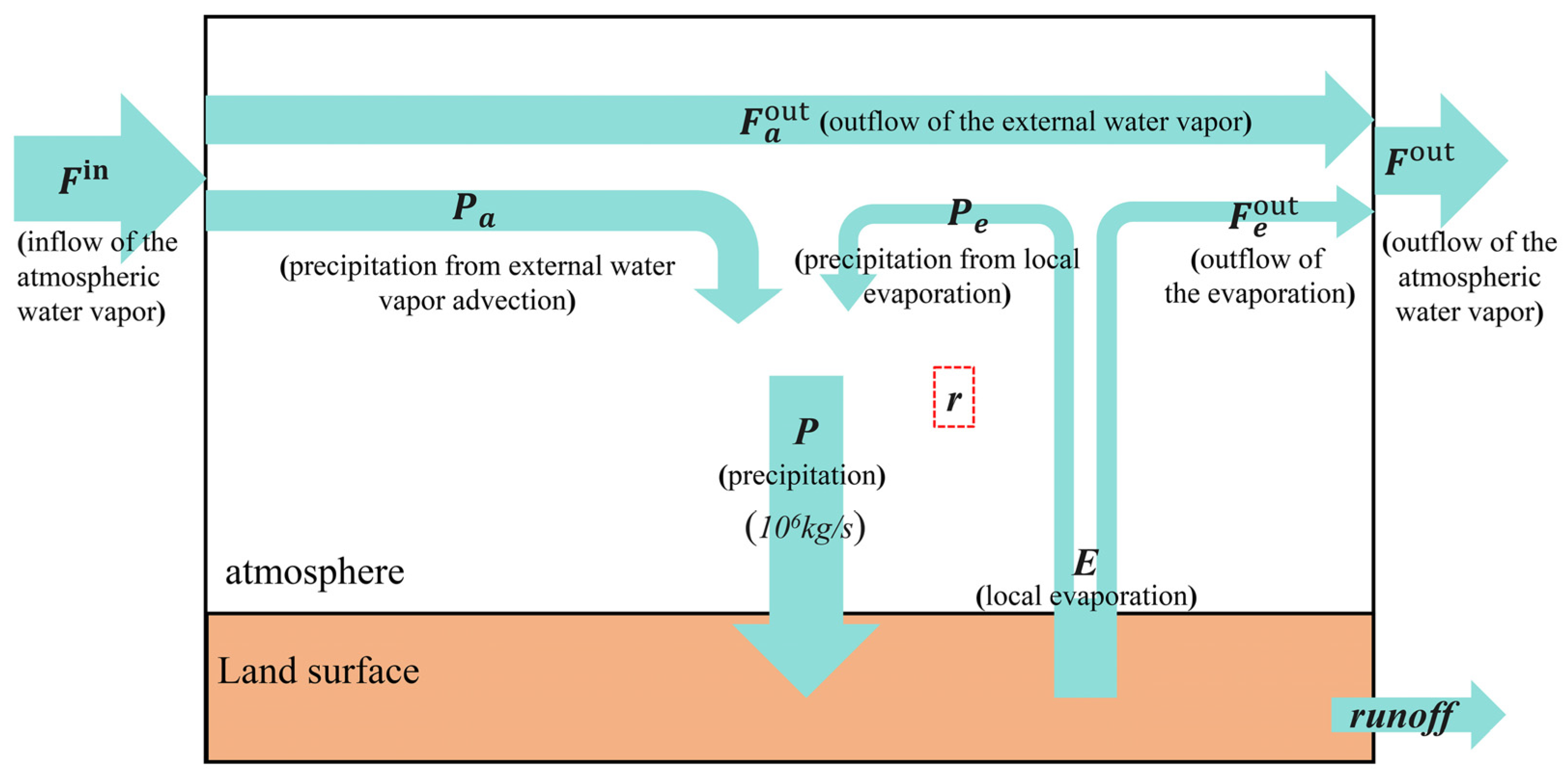
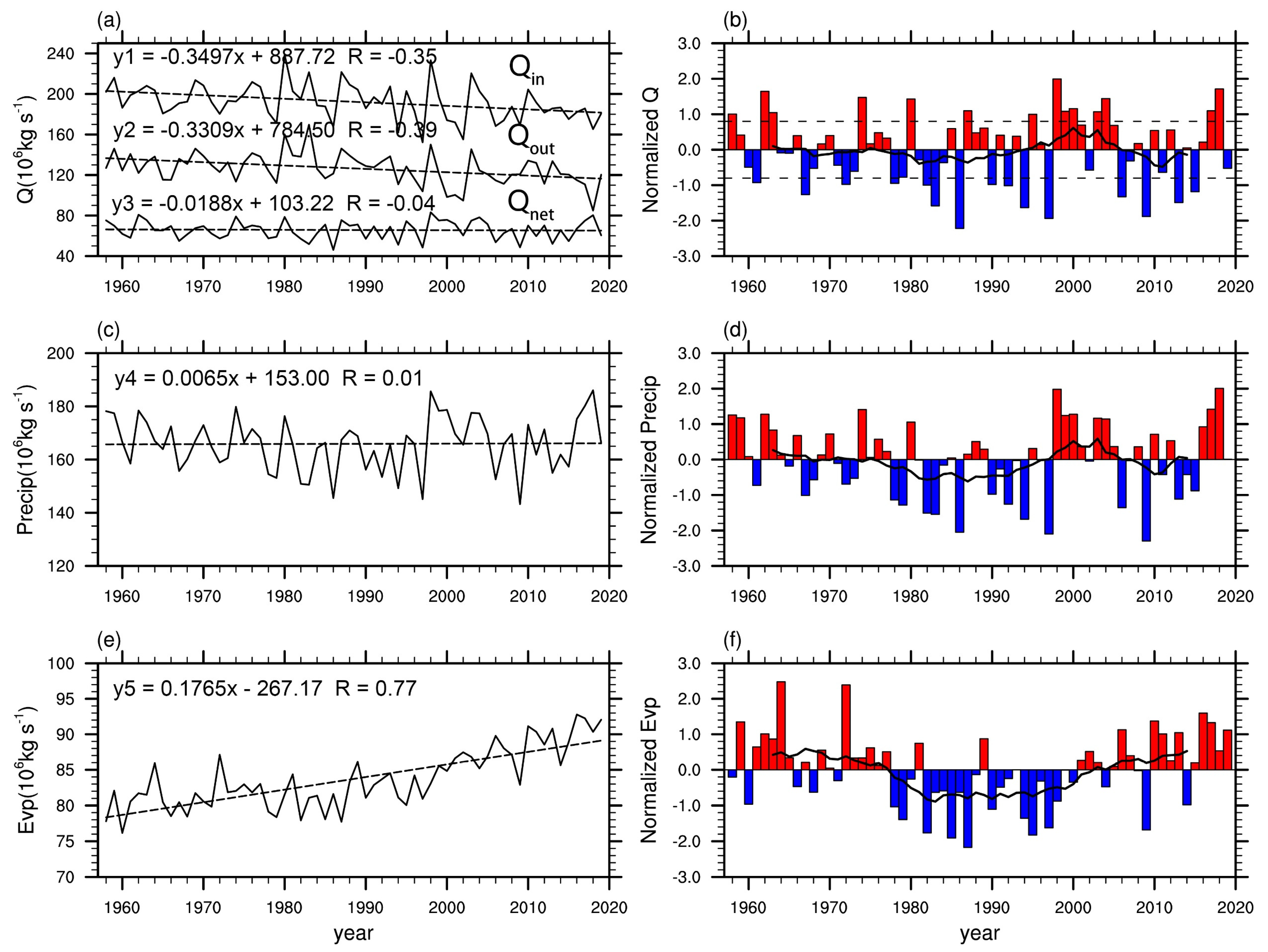
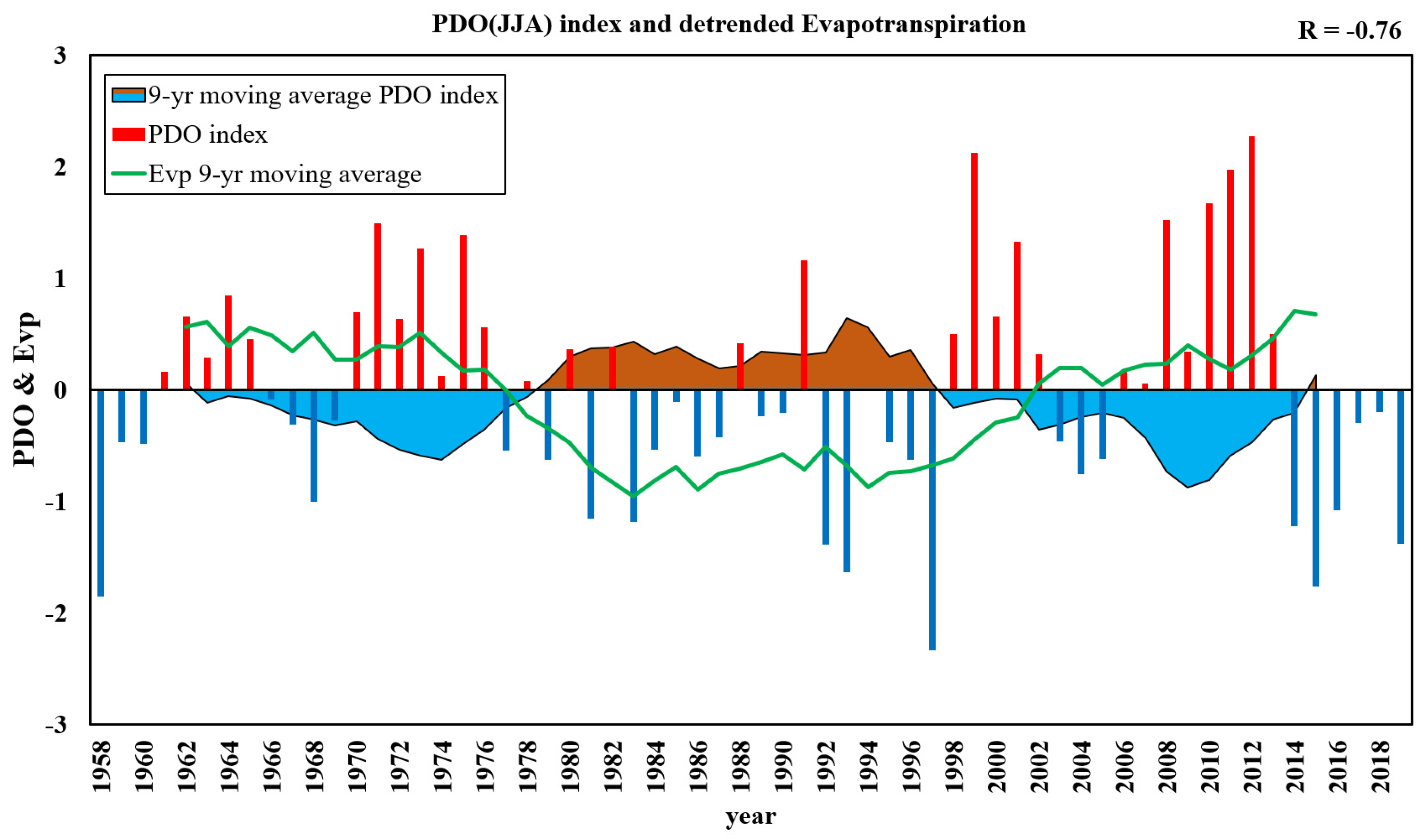
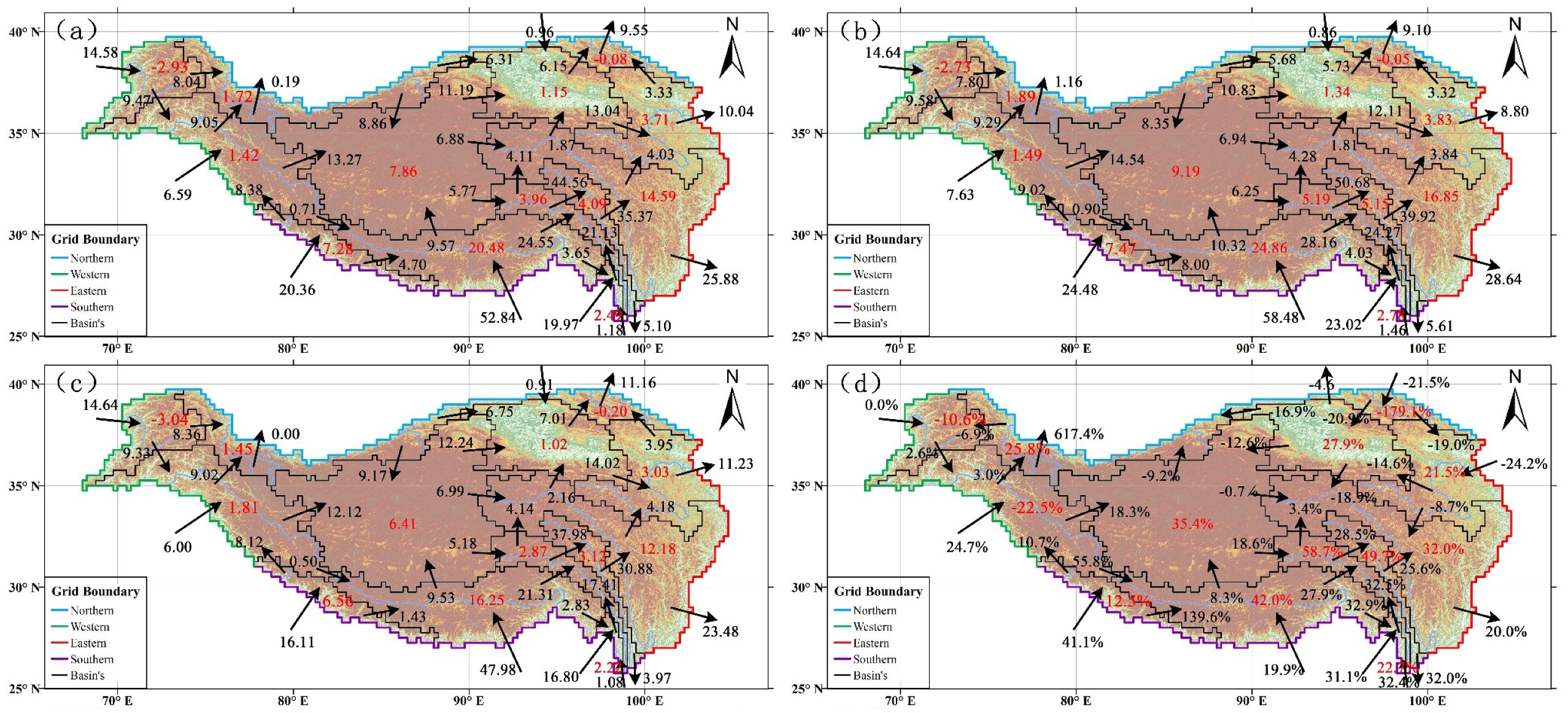
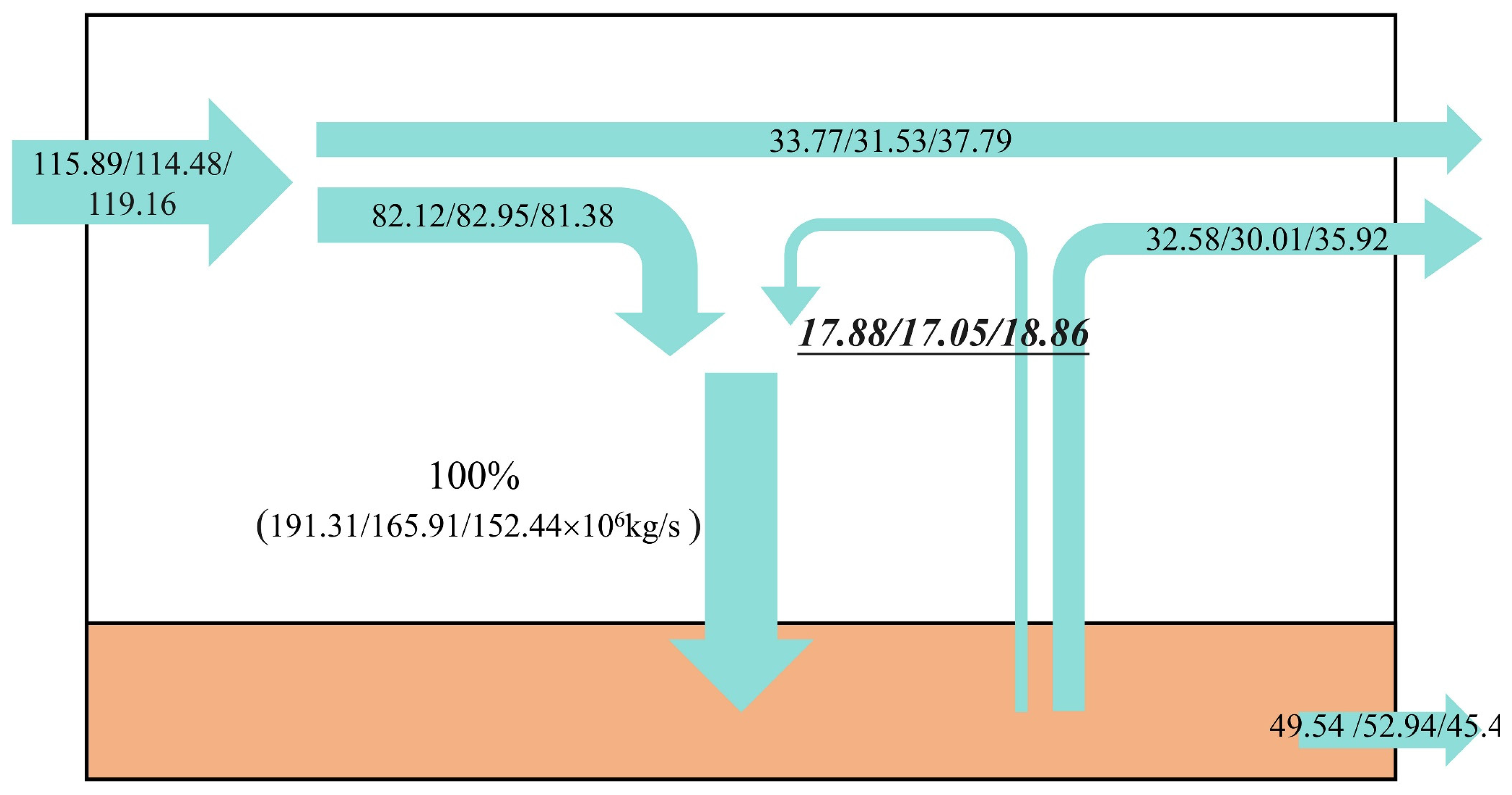
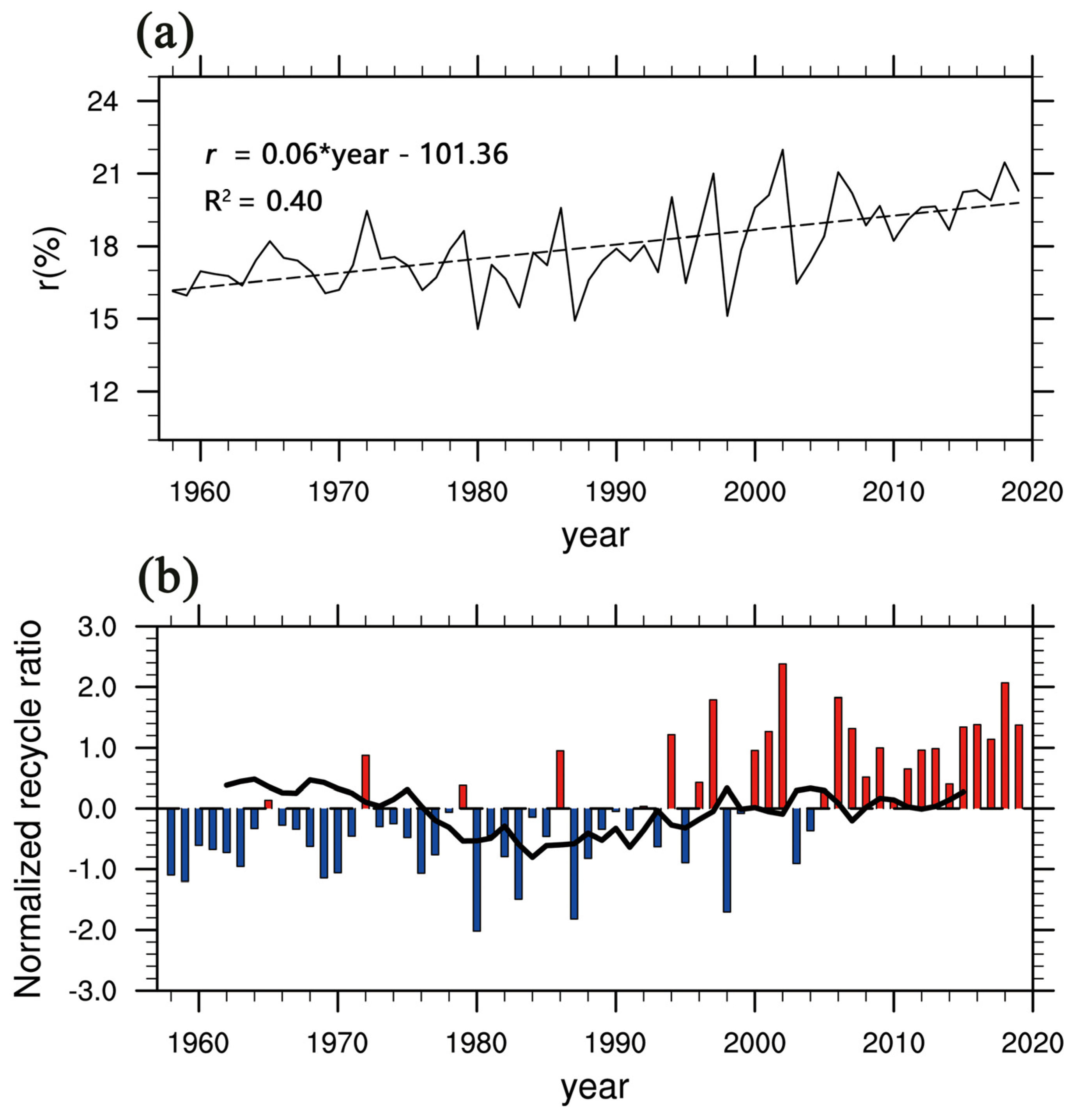

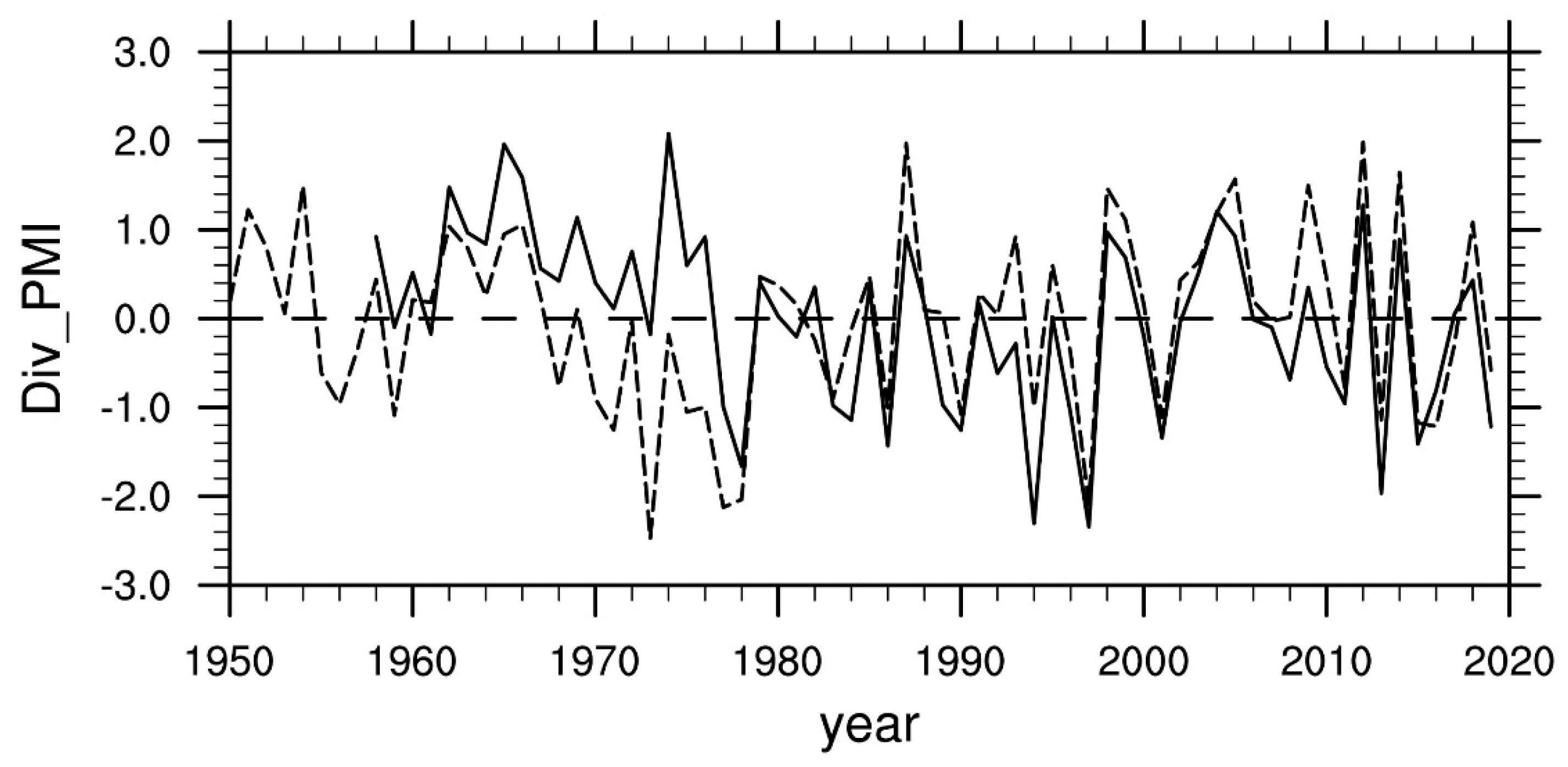

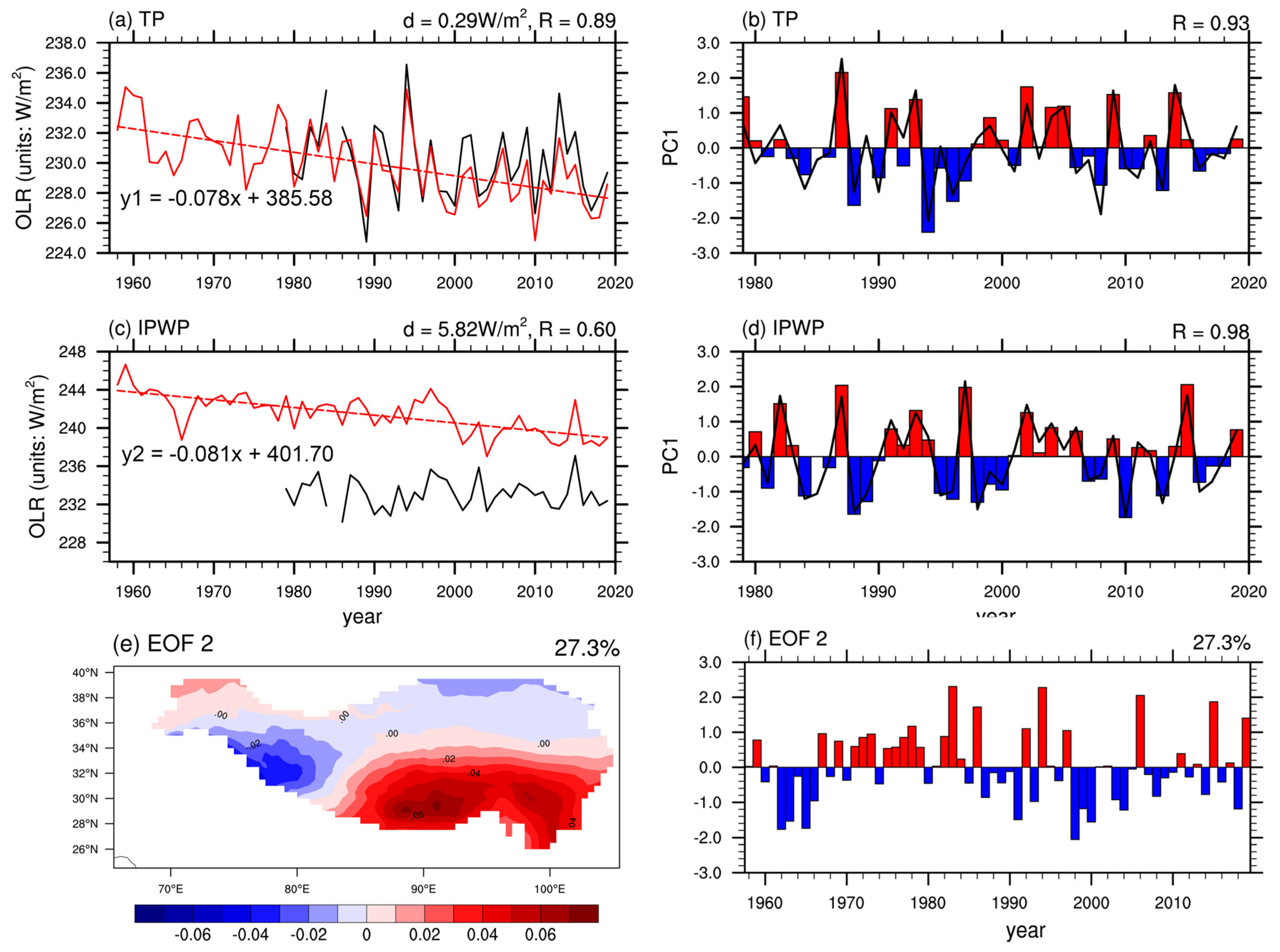
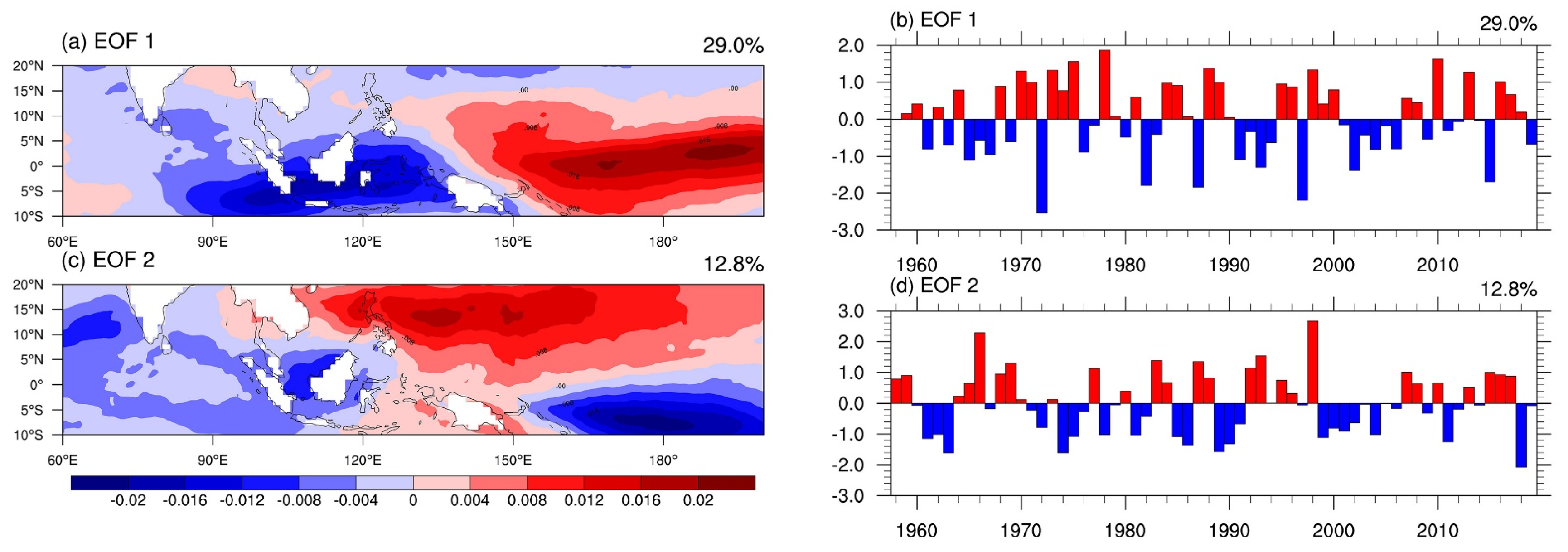
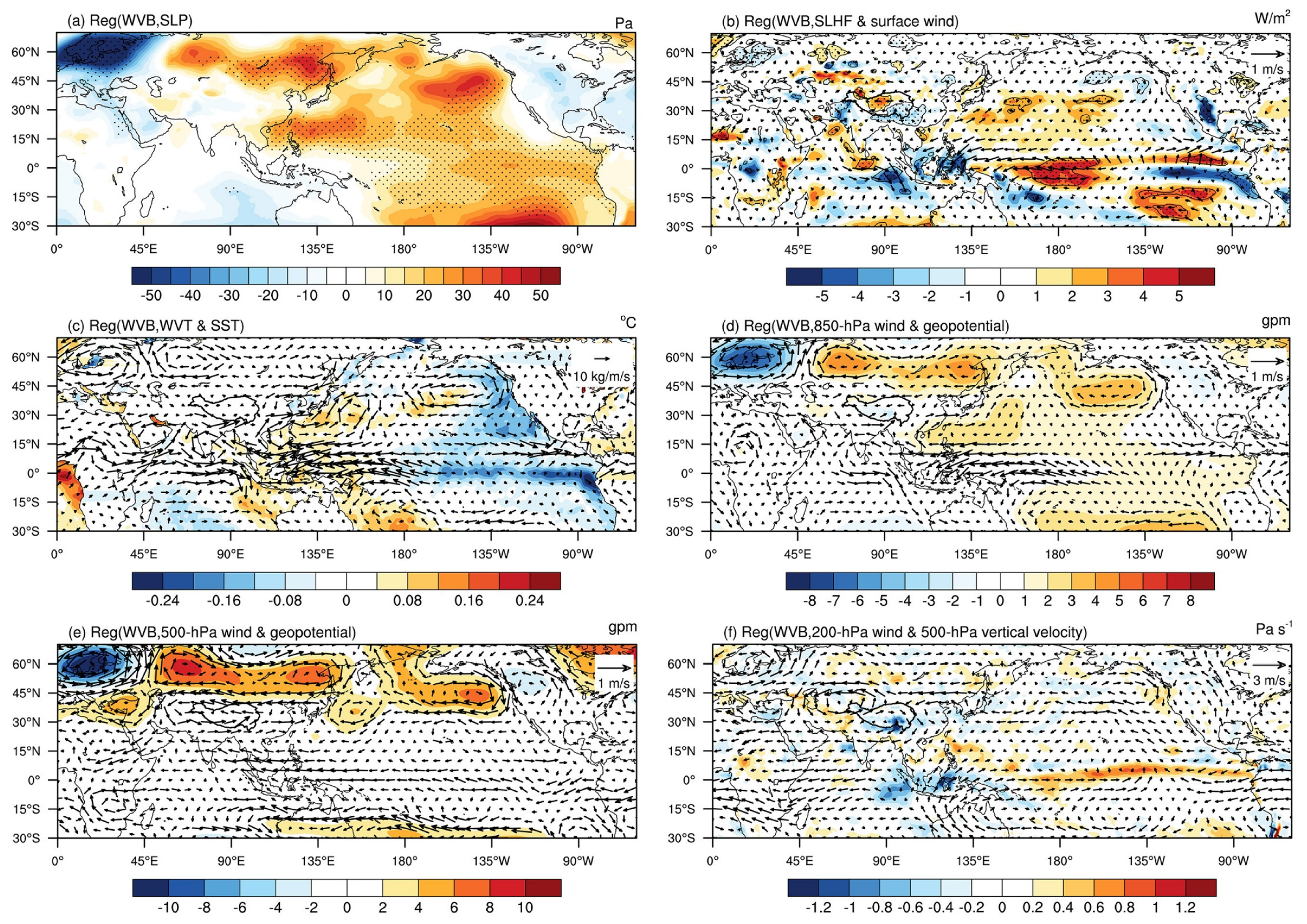
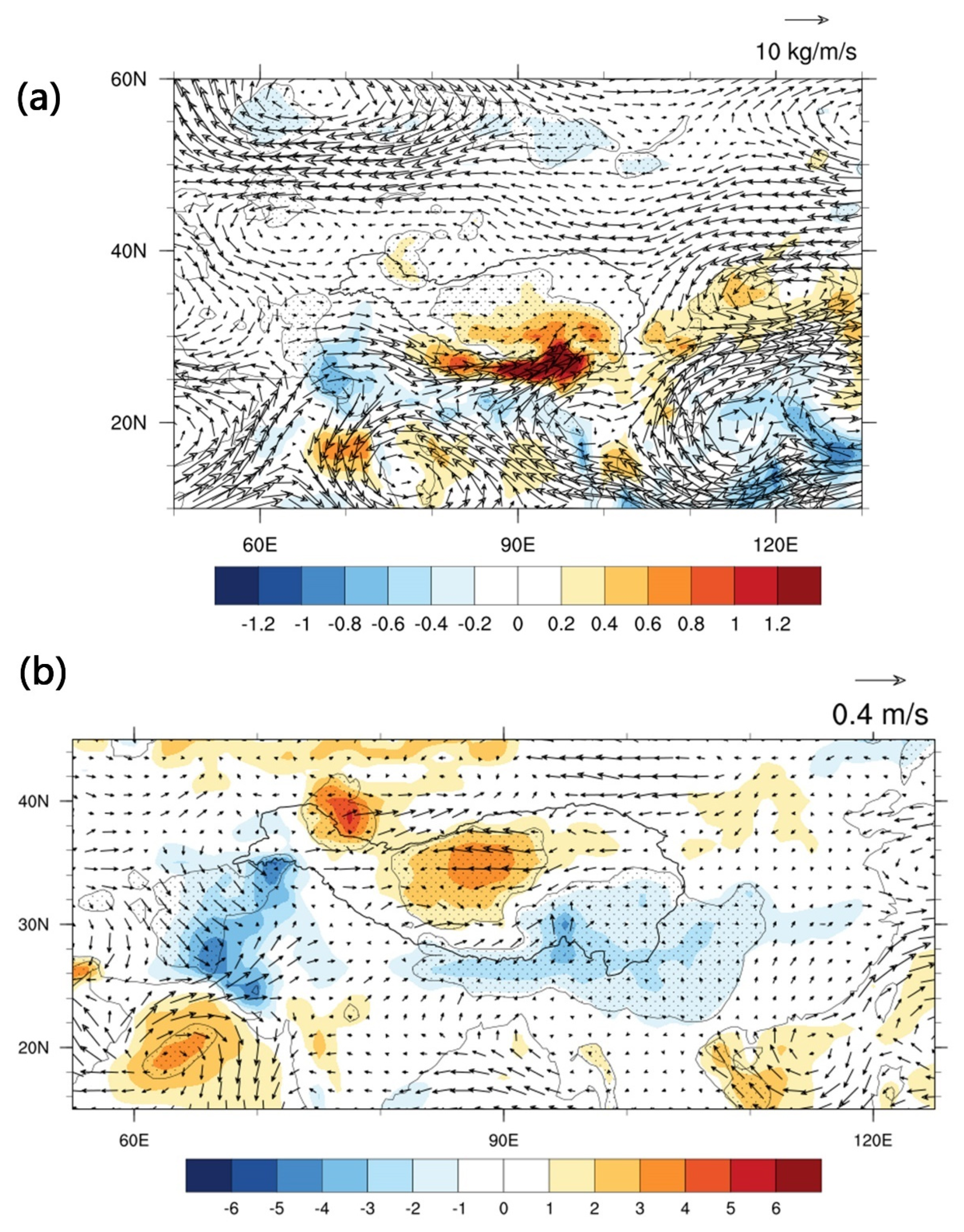
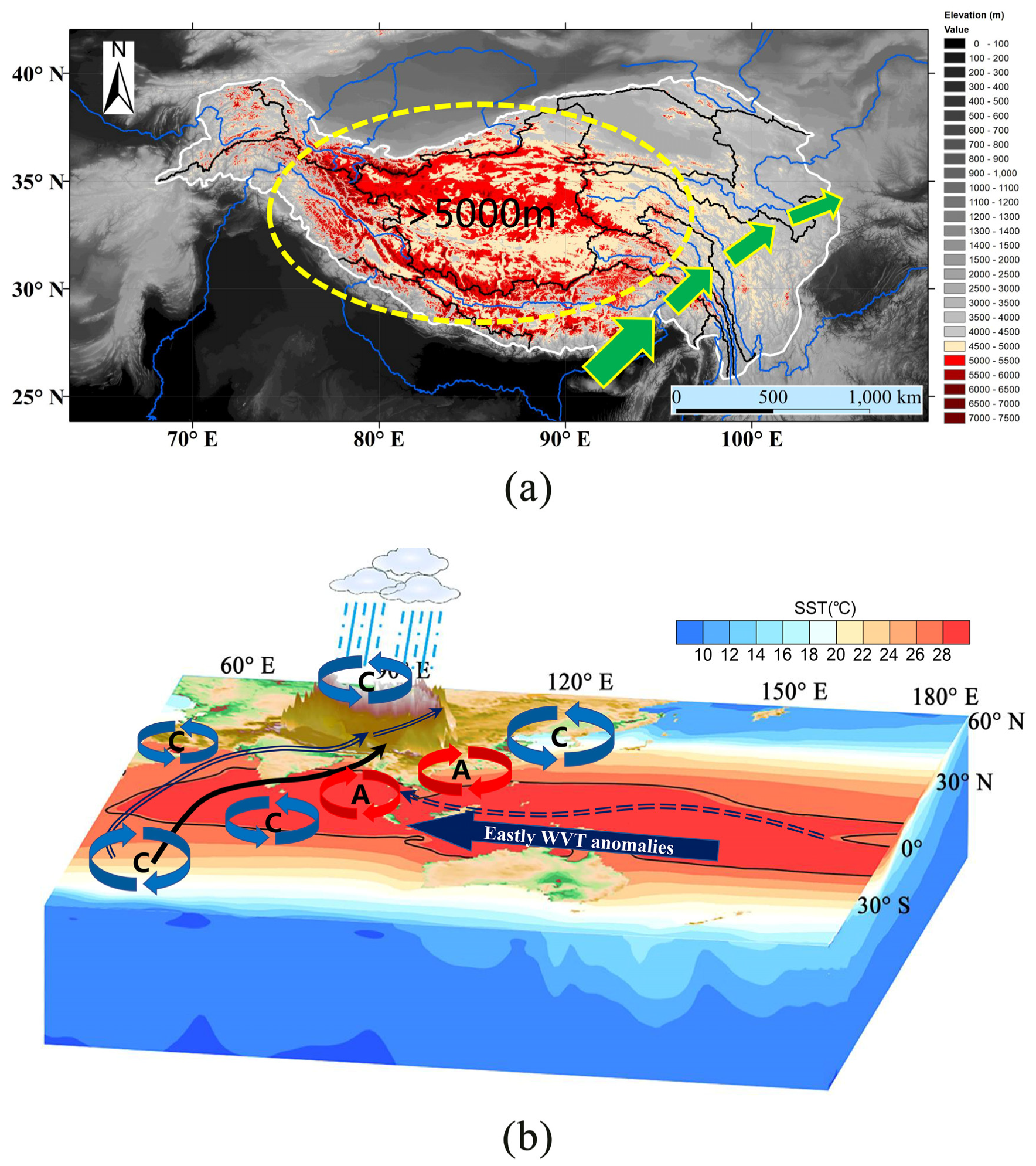
| Area | PRR | Methods | Period | Data | Reference |
|---|---|---|---|---|---|
| TP | 18% | Water Accounting Model (WAM) | 1979–2013 | ERA-Interim and NCEP 1 | [18] |
| TP | 21% | Bulk model | 1979–2012 | ERA-Interim | [20] |
| TP | 23% | Bulk model | 1979–2018 | ERA5 | [29] |
| Southeastern TP | 35% | QuasiIsentropic Back-Trajectory Method (QIBT) | 1982–2005 | ERA-Interim | [39] |
| Northern TP | 20–24% | Bulk model | 1960–2010 | NCEP 1 | [20] |
| Northern TP | 26% | Community Atmosphere Model (CAM) 5.1 tagging | 1982–2014 | MERRA | [40] |
| Northern TP | 15–25% | Isotopic mixing model | July 2009, 2011, 2012, and 2014; July to September 1998 | Station Data | [25,41] |
| Central TP | 14–32% | Isotopic mixing model | July to September, 1996–1997 | Station Data | [32] |
| Endorheic TP | 17–22% | WAM-2 | 1979–2015 | ERA-Interim, MERRA-2, and JRA-55 | [25] |
| Cor | Qin | Qout | Qnet | Pre | Evp | PRR |
|---|---|---|---|---|---|---|
| Qin | 1 | |||||
| Qout | 0.87 * | 1 | ||||
| Qnet | 0.52 * | 0.03 | 1 | |||
| Pre | 0.45 * | 0.03 | 0.94 * | 1 | ||
| Evp | 0.23 | 0.30 | 0.05 | 0.22 | 1 | |
| PRR | −0.90 * | 0.82 * | −0.40 * | −0.26 | 0.62 * | 1 |
| WVB | Year |
|---|---|
| Strong years | 1958, 1962, 1963, 1974, 1980, 1987, 1995, 1998, 1999, 2000, 2003, 2004, 2017, 2018 |
| Weak years | 1961, 1967, 1972, 1978, 1982, 1983, 1986, 1990, 1992, 1994, 1997, 2006, 2009, 2013, 2015 |
| Basins | Climatology | Strong Years | Weak Years |
|---|---|---|---|
| TP | 17.88 | 17.05 | 18.62 |
| Indus | 11.86 | 11.16 | 12.47 |
| Qiangtang | 11.04 | 10.99 | 10.43 |
| Yellow | 9.47 | 9.97 | 8.92 |
| AmuDarya | 9.35 | 9.24 | 9.48 |
| Yangtze | 8.78 | 8.31 | 9.19 |
| Yalung Zangbo | 7.09 | 6.22 | 8.09 |
| Qaidam | 5.63 | 6.30 | 4.78 |
| Tarim | 5.27 | 5.73 | 4.83 |
| Hexi Corridor | 5.24 | 5.92 | 4.53 |
| Ganges | 4.22 | 4.17 | 4.25 |
| Nu Jiang | 3.50 | 3.00 | 4.13 |
| Lancang | 3.42 | 2.97 | 3.99 |
| Irrawaddy | 1.74 | 1.46 | 2.17 |
Publisher’s Note: MDPI stays neutral with regard to jurisdictional claims in published maps and institutional affiliations. |
© 2021 by the authors. Licensee MDPI, Basel, Switzerland. This article is an open access article distributed under the terms and conditions of the Creative Commons Attribution (CC BY) license (https://creativecommons.org/licenses/by/4.0/).
Share and Cite
Meng, D.; Song, W.; Dong, Q.; Yin, Z.; Zhao, W. The Variability of Summer Atmospheric Water Cycle over the Tibetan Plateau and Its Response to the Indo-Pacific Warm Pool. Remote Sens. 2021, 13, 4676. https://doi.org/10.3390/rs13224676
Meng D, Song W, Dong Q, Yin Z, Zhao W. The Variability of Summer Atmospheric Water Cycle over the Tibetan Plateau and Its Response to the Indo-Pacific Warm Pool. Remote Sensing. 2021; 13(22):4676. https://doi.org/10.3390/rs13224676
Chicago/Turabian StyleMeng, Deli, Wanjiao Song, Qing Dong, Zi Yin, and Wenbo Zhao. 2021. "The Variability of Summer Atmospheric Water Cycle over the Tibetan Plateau and Its Response to the Indo-Pacific Warm Pool" Remote Sensing 13, no. 22: 4676. https://doi.org/10.3390/rs13224676
APA StyleMeng, D., Song, W., Dong, Q., Yin, Z., & Zhao, W. (2021). The Variability of Summer Atmospheric Water Cycle over the Tibetan Plateau and Its Response to the Indo-Pacific Warm Pool. Remote Sensing, 13(22), 4676. https://doi.org/10.3390/rs13224676





